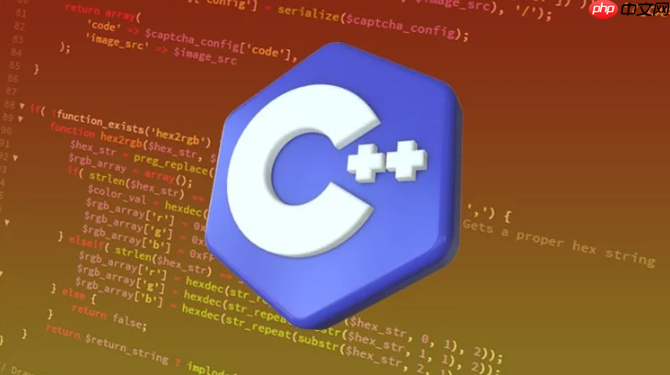在c++++中应尽量避免使用realloc,优先使用std::vector等标准容器。1. realloc缺乏类型安全,需手动进行类型转换并确保类型一致;2. 对象生命周期管理复杂,内存移动可能导致原有对象失效,需手动调用构造和析构函数;3. realloc失败时返回nullptr,原有内存仍需释放以避免泄漏;4. 与new/delete相比,虽在扩展内存时效率较高且兼容c代码,但不支持异常处理,不符合c++ raii风格;5. 若必须使用,应在分配新内存后正确拷贝对象、调用析构,并谨慎处理错误。

realloc
new
delete

要安全使用
realloc

类型安全:
realloc
void*
立即学习“C++免费学习笔记(深入)”;
对象生命周期:
realloc

正确用法:
realloc
realloc
nullptr
#include <iostream>
#include <cstring> // for memcpy
class MyClass {
public:
MyClass(int value) : value_(value) {
std::cout << "Constructor called, value: " << value_ << std::endl;
}
~MyClass() {
std::cout << "Destructor called, value: " << value_ << std::endl;
}
int value() const { return value_; }
private:
int value_;
};
int main() {
// 初始分配
MyClass* arr = static_cast<MyClass*>(std::malloc(2 * sizeof(MyClass)));
if (!arr) {
std::cerr << "Initial allocation failed" << std::endl;
return 1;
}
// 构造对象
new (arr) MyClass(10);
new (arr + 1) MyClass(20);
std::cout << "Original values: " << arr[0].value() << ", " << arr[1].value() << std::endl;
// 重新分配
MyClass* new_arr = static_cast<MyClass*>(std::realloc(arr, 4 * sizeof(MyClass)));
if (!new_arr) {
std::cerr << "Reallocation failed" << std::endl;
// 释放之前分配的内存 (如果 realloc 失败,arr 仍然有效)
arr[0].~MyClass();
arr[1].~MyClass();
std::free(arr);
return 1;
}
// 如果 realloc 移动了内存,需要手动拷贝和构造/析构
if (new_arr != arr) {
// 构造新的对象 (如果需要)
new (new_arr + 2) MyClass(30);
new (new_arr + 3) MyClass(40);
// 销毁旧的对象
arr[0].~MyClass();
arr[1].~MyClass();
// 注意:这里不需要拷贝数据,因为 realloc 已经完成了内存移动
std::cout << "Memory moved by realloc." << std::endl;
} else {
//构造新的对象 (如果需要)
new (new_arr + 2) MyClass(30);
new (new_arr + 3) MyClass(40);
std::cout << "Memory not moved by realloc." << std::endl;
}
std::cout << "New values: " << new_arr[0].value() << ", " << new_arr[1].value() << ", " << new_arr[2].value() << ", " << new_arr[3].value() << std::endl;
// 销毁所有对象
new_arr[0].~MyClass();
new_arr[1].~MyClass();
new_arr[2].~MyClass();
new_arr[3].~MyClass();
// 释放内存
std::free(new_arr);
return 0;
}realloc
在C++中,尽量避免直接使用
realloc
std::vector
std::vector
realloc
realloc
当
realloc
nullptr
realloc
nullptr
realloc
realloc
new
delete
优点:
realloc
realloc
缺点:
realloc
void*
realloc
总的来说,
realloc
std::vector
realloc
以上就是C++中如何安全地使用realloc 类型保留与对象生命周期处理的详细内容,更多请关注php中文网其它相关文章!

每个人都需要一台速度更快、更稳定的 PC。随着时间的推移,垃圾文件、旧注册表数据和不必要的后台进程会占用资源并降低性能。幸运的是,许多工具可以让 Windows 保持平稳运行。




Copyright 2014-2025 https://www.php.cn/ All Rights Reserved | php.cn | 湘ICP备2023035733号